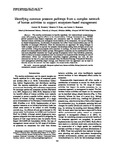Identifying common pressure pathways from a complex network of human activities to support ecosystem-based management
| dc.contributor.author | Knights, Antony | |
| dc.contributor.author | Koss, RS | |
| dc.contributor.author | Robinson, LA | |
| dc.date.accessioned | 2015-07-02T07:46:13Z | |
| dc.date.available | 2015-07-02T07:46:13Z | |
| dc.date.issued | 2013-06-03 | |
| dc.identifier.issn | 1051-0761 | |
| dc.identifier.issn | 1939-5582 | |
| dc.identifier.uri | http://hdl.handle.net/10026.1/3405 | |
| dc.description.abstract |
The marine environment is heavily exploited, but unintentional consequences cause wide-ranging negative effects to its characteristics. Linkage frameworks (e.g., DPSIR [driver-pressure-state-impact-response]) are commonly used to describe an interaction between human activities and ecological characteristics of the ecosystem, but as each linkage is viewed independently, the diversity of pressures that affect those characteristics may not be identified or managed effectively. Here we demonstrate an approach for using linkages to build a simple network to capture the complex relationships arising from multiple sectors and their activities. Using data-analysis tools common to ecology, we show how linkages can be placed into mechanistically similar groups. Management measures can be combined into fewer and more simplified measures that target groups of pressures rather than individual pressures, which is likely to increase compliance and the success of the measure while reducing the cost of enforcement. Given that conservation objectives (regional priorities) can vary, we also demonstrate by way of a case study example from the Marine Strategy Framework Directive, how management priorities might change, and illustrate how the approach can be used to identify sectors for control that best support the conservation objectives. | |
| dc.format.extent | 755-765 | |
| dc.format.medium | ||
| dc.language | en | |
| dc.language.iso | en | |
| dc.publisher | Wiley | |
| dc.subject | ecosystem approach | |
| dc.subject | European regional seas | |
| dc.subject | human activities | |
| dc.subject | linkage framework | |
| dc.subject | marine management | |
| dc.subject | pressure | |
| dc.subject | sustainability | |
| dc.title | Identifying common pressure pathways from a complex network of human activities to support ecosystem-based management | |
| dc.type | journal-article | |
| dc.type | Article | |
| plymouth.author-url | https://www.webofscience.com/api/gateway?GWVersion=2&SrcApp=PARTNER_APP&SrcAuth=LinksAMR&KeyUT=WOS:000320105100006&DestLinkType=FullRecord&DestApp=ALL_WOS&UsrCustomerID=11bb513d99f797142bcfeffcc58ea008 | |
| plymouth.issue | 4 | |
| plymouth.volume | 23 | |
| plymouth.publication-status | Published | |
| plymouth.journal | Ecological Applications | |
| dc.identifier.doi | 10.1890/12-1137.1 | |
| plymouth.organisational-group | /Plymouth | |
| plymouth.organisational-group | /Plymouth/Faculty of Science and Engineering | |
| plymouth.organisational-group | /Plymouth/Faculty of Science and Engineering/School of Biological and Marine Sciences | |
| plymouth.organisational-group | /Plymouth/REF 2021 Researchers by UoA | |
| plymouth.organisational-group | /Plymouth/REF 2021 Researchers by UoA/UoA07 Earth Systems and Environmental Sciences | |
| plymouth.organisational-group | /Plymouth/Users by role | |
| plymouth.organisational-group | /Plymouth/Users by role/Academics | |
| plymouth.organisational-group | /Plymouth/Users by role/Researchers in ResearchFish submission | |
| dc.publisher.place | United States | |
| dc.identifier.eissn | 1939-5582 | |
| dc.rights.embargoperiod | No embargo | |
| rioxxterms.versionofrecord | 10.1890/12-1137.1 | |
| rioxxterms.licenseref.uri | http://www.rioxx.net/licenses/all-rights-reserved | |
| rioxxterms.type | Journal Article/Review |


